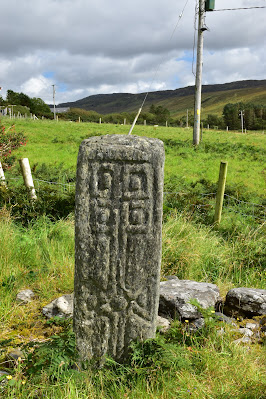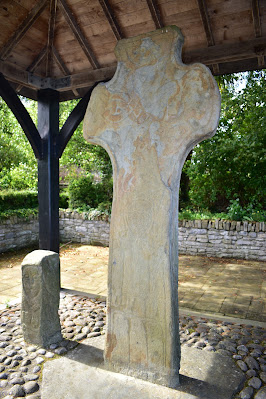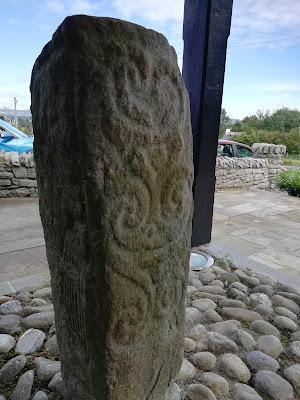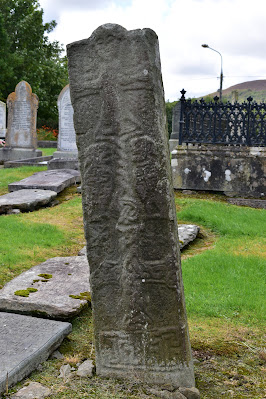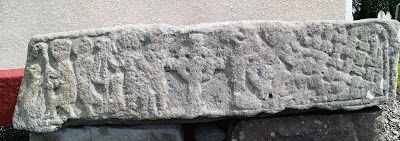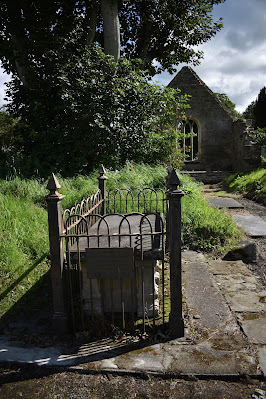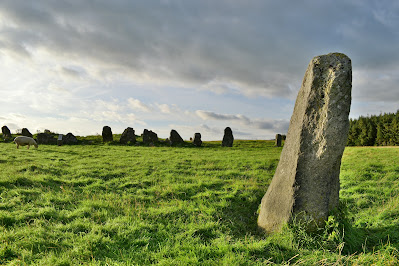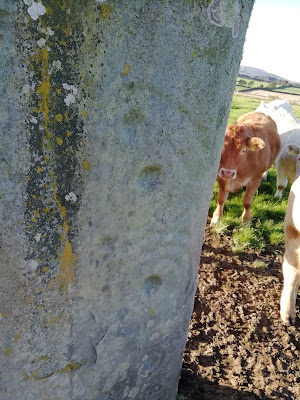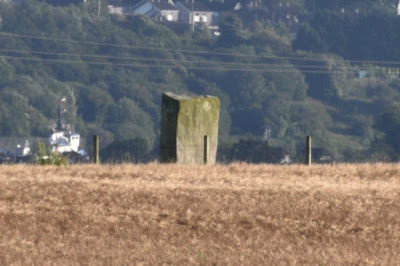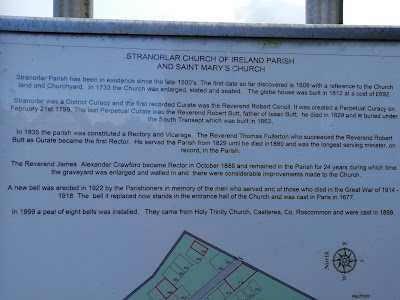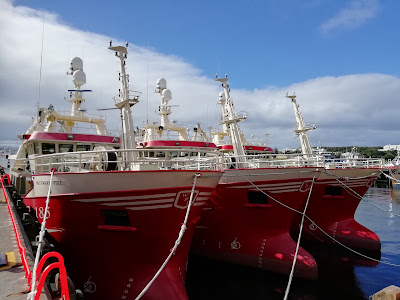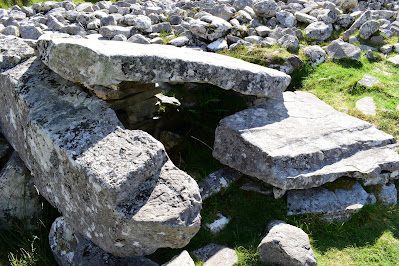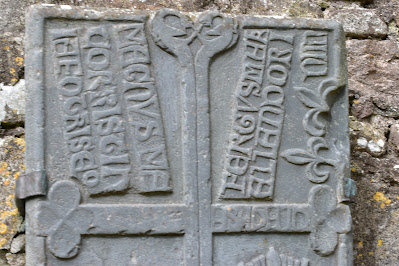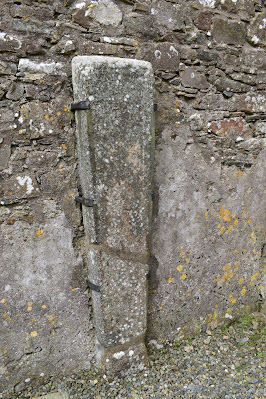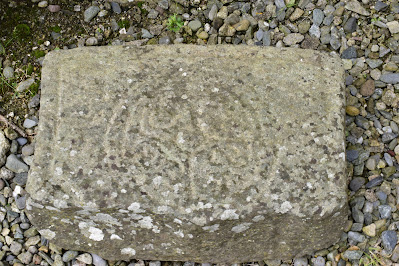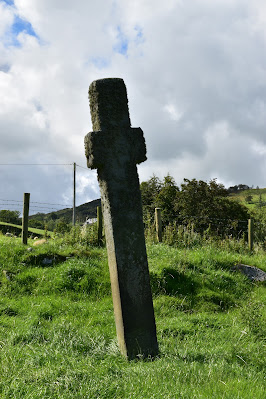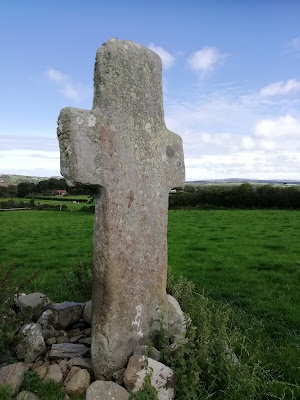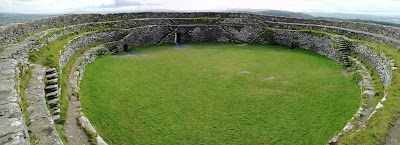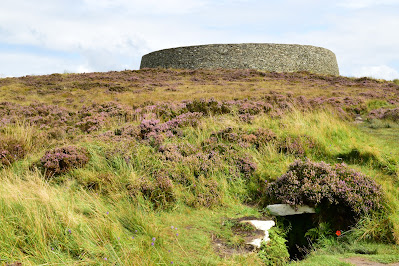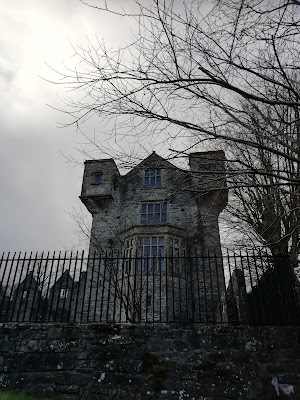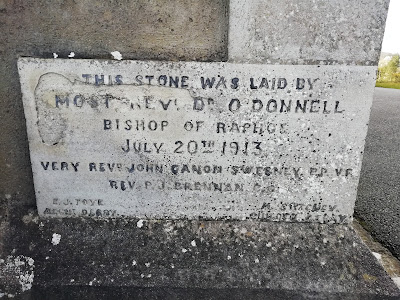Donegal is located both in the Republic of Ireland (Éire) and the Province of Ulster.
It is one of the nine Counties of Ulster, three of which, Donegal, Cavan and Monaghan lie in the Republic of Ireland.
Donegal is a wonderful County to visit.
It is Chockablock with things to see and do with fine Surf beaches, beautiful rivers for Kayaking and panoramic mountains and hilltops.
There are a multitude of Neolithic and Bronze age sites and a wealth of early Christian influences and archaeological relics.
It would be impossible to include every site or place of interest in a single post but I've included some of the more obvious places worth visiting in the County and on the Inishowen Peninsula itself.
Glencolmcille seems as good a place as any to start.
It's a beautiful location and its placename of Glencolmcille (Gleann Cholm Cille) can be translated literally as the Glen of Colm's Church.
Colm was Colmcille, also known as Columba, a 6th Century Patron Saint of Ireland.
He was one of three Patron Saints in Ireland along with Saints Brigid and Patrick.
There is a pretty Folk village in Glencolmcille. I usually steer clear of the word "Folk" or anything associated with it because for a long time use of the word in Ireland was generally associated with substandard or "twee" rubbish served up as history or heritage.
The Irish Tourist Board had a lot to answer for in relation to the type of "Folk" stuff it allowed to flourish for so long.
Thankfully those days are long gone and both visitors and home-birds are more demanding nowadays.
The Folk village at Glencolmcille is beautiful, educational and entertaining. It is well worth taking the time to visit.
As Covid 19 is now well and truly endemic places like the Folk village are a particularly safe environment to visit with an abundance of outside space.
My few photographs taken here don't do the place justice at all.
Glencolmcille is probably best known for the "Stations" also known as the Turas (Journey).
This was a barefoot pilgrimage passing Megalithic remains and various Christian Pillar Crosses and Cross Slabs.
The various carved slabs are of themselves quite beautiful and a small guide to the Turas can be bought in the Folk village making navigation of the journey a little easier.
I'd strongly advise keeping the shoes on though.
Many Christian slabs and pillars are dotted throughout Donegal but they're easiest to see close together at Glencolmcille.
The Sea views of the ocean from Glencolmcille and nearby are outstanding.
A mention should go to the Slieve League (Liag) Sea cliffs in Donegal before I forget.
These Sea Cliffs are reputed to be among the tallest in Europe. They are also free to visit or at least they were last time I visited. Unfortunately I seem to have misplaced any photo's I had of the cliffs.
It would appear that it is now a paid "Visitor Experience" although I assume it is still free to cycle to the top. I'd suggest phoning in advance or sending an email to check.
Sticking to the Christian theme Carndonagh on the Inishowen Peninsula has a wonderful example of an early High Cross believed to date to the 7th Century.
If this is correct it would make it the finest example of its type for the period. The carvings on the cross are quite intricate and beautiful to see up close.
The Cross has been dated by reference to Crosses in the Book of Durrow, an early Christian Manuscript from Offaly. The High Cross is called Saint Patrick's Cross.
There are also some delightfully carved Pillar Stones (Stele) beside the High Cross and both the small Pillars and High Cross are thankfully covered with a protective overhead canopy.
My photographs were taken in poor lighting and I couldn't seem to capture the full detail of the Cross.
I thought a figure on one of the Pillars resembled a Cat but I'm sure it's something different altogether, although just quite what I haven't found out yet but it looks like medieval headwear.
Just behind Saint Patrick's Cross is
There is a fantastic stone in the Churchyard, the Marigold Stone.
The Marigold is a recurring theme and appears on several carved Christian Stones in Ireland.
This Pillar Stone is beautifully carved with a type of ecclesiastical Fan carved onto it which has the Marigold as part of the Fan.
I hadn't previously know this however the Fan is called a Flabellum which is a type of Ceremonial fan.
There are also figures carved onto the stone but yet again the light was fighting me for some reason and I couldn't get decent pictures.
It appears to be a depiction of Jesus with two figures below and to either side of him.
There is another simpler carved slab nearby as well as a beautifully carved stone near the entrance to the present Church which is believed to be a lintel from an earlier building.
It is unusual to have so many early Christian relics gathered together in such close proximity and with such easy access.
I can't recommend a visit to Carndonagh highly enough. It's well worth travelling to.
There is a Mass Rock nearby too, a relic from the Penal Laws in Ireland but I didn't have time to locate it.
It is speculated that Saint Patrick's High Cross at Carndonagh is an early example of the transition from Crosses carved onto a large Slab such as that at Fahan beginning to be carved as large "standalone" Crosses.
It sounds plausible however exactly how true that is we will never know.
Saint Mura's Cross at Fahan "old Church" in Donegal is a stunning example of a large carved stone Cross Slab. It is both quite large and quite beautiful.
The Craftspeople who carved these stones were extremely skilled.
The detail is outstanding and the geometric precision with which it was carved is breath taking. This stone may originally have been carved 1500 years ago.
I am always amazed at the skill demonstrated and on display at these various stones.
Embedded in the outer wall at Fahan there is a small stone with another Cross carved onto it.
A Church is known here from the 16th Century and this Cross may have originated from either that or an earlier Church.
Another interesting antiquity is also found in the outer wall at Fahan old Church.
It is simply described as a "holed stone."
At first sight it struck me as possibly the remnant of a Millstone.
There are many traditions and myths associated solely with "holed stones" which serve no other purpose than the tradition once associated with them so it's possibly not a Mill stone at all.
Examples include oath, swearing and cursing stones.
A particularly famous woman most of us have probably never heard of is buried at Fahan, Agnes Jones.
Agnes was a Nurse who was born in 1832.
At one stage she was Superintendent of the Liverpool Workhouse Infirmary where she worked through a Typhus epidemic. A signpost and a small Plaque mark her final resting place at Fahan old Church.
She contracted Typhus fever herself and died in that epidemic of 1868. Agnes spent some time working with Florence Nightingale who apparently held her in high regard.
Just across from Fahan old Church is Saint Mura's Church of Ireland. It's style is reminiscent of a
Of maritime interest at Saint Mura's is a memorial in the Church Graveyard to the
This ship started life as the R.M.S. Laurentic and was sunk by mine near Lough Swilly in 1917.
It was the largest loss of life ever to mining at Sea. At least 370 lives were lost and many were buried in a mass grave at Saint Mura's.
The ship was secretly carrying 3,200 bars of Gold when it was sunk.
Moving abruptly to a monument from the Bronze age I'll mention the Beltany Stone Circle in Donegal, a wonderful example of the type, before listing a little known oddity.
Beltany is a particularly fine example and set in bucolic surroundings.
Some of these Stone Circles may be as much as 4,500 years old and are presumed to be Bronze Age Ceremonial monuments.
Exactly what type of ceremony is unknown. Prayer rituals, Worship, Sacrifice, Feasting, Dancing....No one is exactly sure.
The Stone Circles may well have had some type of celestial alignment associated with them. They sometimes have single upright stones close by.
Possibly there may also have been some type of processional walkway into the Circle which we don't see now.
Many Stone Circles in Ireland have been destroyed or ploughed into the ground but those that remain serve as a nice reminder of past activity and intellect. These people were smart.
A triangular stone in the Circle is covered in multiple Cup marks, a type of small hollow often found carved onto Bronze age monuments and stones.
The Bronze Age oddity in Donegal is the Ardmore Stone. This is a seriously unusual monolith.
It is a huge upright rectangular stone near Muff on the Inishowen Peninsula. It is covered in Cup and Ring markings. Many of the Cup marks have concentric rings around them.
Trying to estimate its weight visually is impossible. I have no idea how much of it is embedded beneath the soil.
As an uneducated guess I'd imagine it's over 10 ton in weight. The stone is on private land beside a Farmhouse.
The owner Séan kindly gave me permission to enter. Between the curious Cows nudging me and the falling light, photography proved a little difficult.
The stone can be difficult to locate but if you ask around and try to contact the landowner you'll be rewarded for your efforts handsomely.
I've included a few photographs taken from a distance across fields to try provide some perspective on this huge monolithic orthostat.
It is massive and when I first saw it across the fields I immediately thought of the monolith in the Kubrick movie, 2001: A Space Odyssey.
Coordinates for the Ardmore Stone are listed at the page in the link. I know it's a bit odd but it is really worth visiting if "old stones" are your thing.
In a leap through time using Quantum loop gravity I suddenly arrive at Stranorlar.
Unfortunately I have no photographs to show you of the picturesque Finn Valley which I travelled through on my journey nor of the Fintown railway.
A more panoramic setting would be hard to find. The Fintown railway is a small section of restored County Donegal railway.
The Valley is surrounded by mountains and part of the railway runs alongside Lough Finn. Today there is a modern road through the valley but not so very long ago it was traversed by way of a rough Boreen, perhaps with a Donkey and Cart.
Mention Home Rule
(the struggle for self governance in Ireland within the Union of Great Britain and Ireland) and the name that springs to mind is Charles Stewart Parnell.
Parnell came to be the leader of the Home Rule movement however its founder was the lesser well known but hugely important Isaac Butt.
There is a bridge in Dublin, Butt Bridge, named in his honour.
History was for a long time little taught in Ireland beyond the basics and Isaac Butt is often overlooked.
To provide some historical context just a single T.D.
(member of the Irish Parliament)
entered the Cathedral for the state funeral of the First President of modern Ireland and founder member of the Gaelic League, Dr. Douglas Hyde, lest they burn in Hell for eternity or be excommunicated from the Church.
Isaac Butt died in 1879 and is buried at Saint Mary's Church of Ireland, Stranorlar, Donegal.
On a maritime note Killybegs is an important fishing town where a large volume of catch is landed. A few vessels known as "Super Trawlers" operate out of the harbour alongside many smaller vessels.
Located at Saint Mary's R.C. Church in the town is an interesting 16th Century Grave slab. It is displayed outside the Church in a large glass display case for protection.
Known as the McSwyne Grave Slab it depicts among other things a Gallowglass, a medieval mercenary soldier. Once again I've not taken great photo's so it's better you go and see for yourself.
The figure seems to be wearing chainmail and is clearly holding a battle Axe and wearing a helmet.
It purportedly represents one Niall Mor MacSweeney. It's nice to see it afforded protection from the elements and preserved for the enjoyment of future generations.
There are plenty of small cafes and eateries scattered throughout the town making it an excellent spot for a lunch stop. No problem Killybegs, stick the tenner in the Post.
Anchors away......
Using my time machine again I've jumped back roughly 6,500 years to the Neolithic period in Ireland when Ireland's first farmers appeared.
This was long before "Setaside" and E.U. subsidies.
At Malinmore in Donegal there is a nice Court Tomb.
These are synonymous with the North west of Ireland although a very few are found further south.
They are called Court Tombs because there was an open circular court type enclosure facing in towards the Tombs.
There is another large example of a Neolithic Court Tomb further south at Creevykeel in Sligo close to the Donegal border.
It's hard to see and appreciate the full detail and layout at ground level.
Although I hate to state the glaringly obvious, perhaps in their infinite wisdom the OPW might install a raised viewing platform for visitors to use.
There are quite a few examples of smaller or more ruinous Court Tombs found throughout Donegal.
It was a hotspot of early Neolithic activity in Ireland with many monuments scattered about the landscape.
The small Donegal village of Glenties is nestled close to the Bluestack Mountains.
It is home to the annual
"MacGill Summer School."
Patrick MacGill was a Navvy (railway worker) who became a celebrated writer, journalist and poet amongst other things. The summer school was originally held in his honour..
Turning all ecclesiastical again
(that would be an ecumenical matter Ted)
and I'm going full circle back to the beautiful Irish High Cross.
More often than not we imagine the High Cross with a big circle or ring near the top.
Those are the High Crosses we are most familiar with.
The modern incarnation seen in almost all graveyards and Cemeteries are often called
"Celtic Crosses."
High Crosses are believed to be called such because they are indeed high, tall and towering.
Large, tall examples at Moone in Kildare and Monasterboice in Louth are prime examples.
A lot of the High Crosses in Donegal are unusual for the type in that they are simply Cross shaped.
They do not have a circle or ring intersecting the shaft and arms of the Cross.
This does not make them any less interesting or historic. Indeed the High Cross at Clonca in Donegal is covered in intricate carvings and details.
The Clonca High Cross is unusual in another detail....There are the remnants of another fallen Cross in the nearby field. A decorated and ringed imperforate High Cross.
A further reason to visit the Clonca High Cross if one were needed is the interesting and unusual relic in the ruined 17th Century Church nearby.
This is the Magnus and Fergus Grave slab, a relic probably dating from the 1500's.
This Grave slab is richly decorated and has a carved inscription translated as
" Fergus Mac Allan made this stone - Magnus Mac Orristin under this."
Carved onto the slab are included a Sword, a Hurley and Sliotar (ball), a decorative Cross and some Fleur de leys. The details are fantastic.
On the top of the Cross two birds are intertwined and there are flowers on the end of the Cross arms along with a further inscription. The bottom of the Cross ends in a swirled pattern of plant leaves.
I know of no other Cross slab in Ireland with a Hurley and Sliothar carved onto it. It is highly unusual indeed.
The Sword would suggest that whoever Magnus was he knew how to both fight as well as play at Hurling.
There is a later 17th Century plain Grave slab, a small Bullaun stone I missed and a small decorated fragment along with another inscribed stone which I also missed in the rapidly falling light.
All in all there's a lot to take in at Clonca and I can see a return visit is long overdue.
The doorway lintel appeared to have some faded carvings on it and I think only some type of computer emulation or software program would be able to show them for what they may have once been.
Sticking to the High Cross theme there are two further High Crosses at nearby Carrowmore.
Carrowmore is described as an "ecclesiastical settlement" due to the large number of early Christian archaeological artefacts in the small area.
It is believed a large complex must have stood here at one time.
Unfortunately due to time constraints I could only stop off to quickly visit the two High Crosses in fields on opposite sides of the small roadway.
Both Crosses are freestanding and unringed Crosses. One is particularly slim in side profile.
They are almost directly opposite each other and there are I believe, some small carved stones nearby if you have the time free to look for them.
Straight from Early Christian Ireland I take a great leap forward to WWII and American Pilot Bud Wolfe of Nebraska.
By all accounts Bud seems to have been a brave, colourful and interesting character.
While on Patrol he ejected from his Spitfire aircraft, P 8074, which subsequently crashed heavily into bogland where it remained buried until it was rediscovered and excavated in 2011.
Its machine guns and ammunition were among several other items recovered as well.
At Cnoc an Uininn viewing point on Glenshinny Mountain there is a Plaque that tells the tale of Bud and the recovered Spitfire.
The uplands and hills here are well worth traversing to enjoy the tranquillity and scenery.
Interestingly the Spitfire was paid for by a wealthy Canadian, Garfield Weston.
His son Galen Weston would move to Ireland and open a chain of Supermarkets as he began to make his fortune.
In my usual bouncing around method in illogical fashion on this post I am now winding the clock back to the Iron age in Ireland, roughly between 500 B.C.E and 500 C.E.
Grianán of Aileach is a spectacular Hilltop fort near Burt on the Inishowen peninsula.
These forts were and still are in Irish called Cashels.
They are usually thought to have been built during the Iron age in Ireland.
In this instance The National Monuments Service has Grianán of Aileach listed as presumed built c. the 8th or 9th Century whilst still others claim it as 4th or 5th Century.
Perhaps one day it might be dated more specifically when further archaeological evidence emerges however for the time being that's the information available to me at present.
The Cashel itself is impressive if only for the depth of the surrounding walls.
Probably what is even more impressive is what we can't see and what may once have stood alongside the Cashel and was used in conjunction as further defences.
The Stone Hilltop Fort at Rathgall near the Wicklow/Carlow border springs to mind with several defensive walls (multivallate) surrounding it.
Human activity at Grianán of Aileach predates the present structure.
Activity has perhaps been continuous since the Neolithic era, right through the Bronze age and into the Iron and early Christian and medieval period in Ireland.
Saint Patrick is reputed to have visited the Hilltop.
Close by and off to one side is Saint Patrick's Well, hidden beneath drifts of purple flowering Heather and often overlooked on a casual visit.
The views from the Hilltop are fantastic on a clear day.
The Cashel was heavily restored in the late 1800's however this doesn't detract from either the historic nature or beauty of the location. It is well worth taking the time to visit.
My memory of the Pub in question has faded so I've no specific recommendation.
There are several architecturally interesting Churches in the town and a sign posted Heritage trail.
I have never had the opportunity or time for a good wander around when passing.
There is a Castle in the Town which was closed when I last had a chance to stop but I believe it is open again.
Architecturally I would describe it as an Irish Tower House with later Elizabethan style additions and modifications however I'm no architect.
It reputedly belonged to
"Red" Hugh Roe O'Donnell
who later died in Spain after defeat by the English at the Battle of Kinsale in County Cork.
A quick mention goes to the tiny village of Bruckless in Donegal for its pretty and enchanting contemporary Round Tower built c. 1860.
It's beside the R.C. Church of Saints Joseph and Conal. I really love these tiny villages, great places to stop off and enjoy.
Irish Round Towers are unique and only about 85 full and partial Towers remain. I believe two were built in Scotland and one on the Isle of Man.
They most probably originated as Bell Towers but no doubt served a range of functions. It would take a complete book to adequately cover them but if you're travelling around do take the time to visit a few of the original examples.
The foundation stone was laid by a Reverend O'Donnell. Perhaps a distant relative of Red Hugh O'Donnell?
I've left out what is probably one of Donegal's most visited attractions. The reason I've left it out is somewhat ironic. It is because I've never actually got round to visiting it myself.
The attraction in question is
It was built by a man who was reputedly the most hated man in Donegal, John George Adair also known as Black Jack Adair.
Adair was from County Laois in the Irish midlands. He amassed a huge ranch of over one million acres in the U.S.A. called the J.A. Ranch
Because I haven't visited Glenveagh I don't have any photographs of the beautiful and huge castellated mansion there. Entrance to the surrounding gardens and National Park is free.
I do however have a photograph of the final incongruous resting place of Black Jack Adair, Glenveagh Castle's original owner. It is literally "just down the road" from where I live in the midlands.
I have also included a photograph of the beautiful Church with its stunning Romanesque doorway which his widow Cornelia built in County Laois.
It was built in Adair's memory while the once beautiful ancestral home,
Bellegrove House, an Italianate style mansion was burned to the ground, most likely deliberately, and lies nearby.
The ruined Italianate mansion and quiet burial place stand in stark contrast to the brash, supposedly rude and immensely wealthy and indulgent lifestyle he led.
A stark Memento Mori for us all perhaps.
An all too brief mention goes to Assaranca Falls which lies in an outstandingly beautiful area and is also well worth putting on any travel itinerary.
I have left out the multitude of fine surfing beaches including Rossnowlagh and a host of towns and villages including Bundoran, Ballyshannon, Raphoe etc. etc.
There is just too much to see and so little time..............
Suggested Reading and Reference :
Pilgrimage in Ireland - Peter Harbison
Guide/National Monuments Ireland - Peter Harbison
Wild Ireland - Brendan Lehane
The Irish Landscape - Frank Mitchell
Irish Field Monuments (Booklet) - The Office of Public Works










